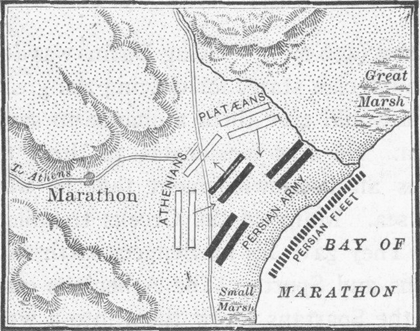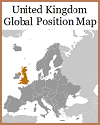Map of the Battle of Marathon, 490 B.C.E., in Ancient Greece: This battle in Marathon, Greece, was a decisive Greek victory. According to the Greek historian Herodotus, the Persians suffered 6,400 casualties. It marked the end of the first Persian invasion of Greece. Click here to enlarge.
 The Battle of Marathon, fought in 490 B.C.E., was a pivotal engagement in the Greco-Persian Wars, a series of conflicts between the Greek city-states and the Persian Empire. This battle is famous for the Greek victory and the remarkable marathon run, which inspired the modern marathon race.
The Battle of Marathon, fought in 490 B.C.E., was a pivotal engagement in the Greco-Persian Wars, a series of conflicts between the Greek city-states and the Persian Empire. This battle is famous for the Greek victory and the remarkable marathon run, which inspired the modern marathon race.
Background: The conflict began when the Persian Empire, under King Darius I, sought to expand its influence into Greece. The Greek city-states, particularly Athens and Eretria, supported a rebellion in the Persian-controlled territory of Ionia (in modern-day Turkey).
Key Participants:
- Persians: The Persian forces were led by Datis and Artaphernes, two of Darius's generals.
- Greeks: The Athenians, under the leadership of their generals Miltiades and Callimachus, along with a smaller force from Plataea, made up the Greek army.
Battle Details:
- Location: The Battle of Marathon took place on the plains of Marathon, a coastal area northeast of Athens, Greece.
- Persian Forces: The Persians had a significant advantage in numbers and were well-equipped, but their infantry and cavalry were heavily reliant on archery.
- Greek Forces: The Greek army was smaller but composed of well-trained hoplites, heavily armored soldiers known for their distinctive round shields and long spears.
- Miltiades' Strategy: The Greek generals decided to take advantage of the marshy terrain on one side of the battlefield, which would neutralize the Persian cavalry. Miltiades developed a plan to attack the Persian center while extending the Greek flanks.
- Greek Phalanx: The Greek phalanx formation, a tightly packed and shielded infantry formation, advanced against the Persian infantry.
- Greek Victory: The battle was intense, with both sides suffering heavy casualties. However, the Greek hoplites managed to break through the Persian center. With their center compromised and their flanks threatened, the Persian forces were thrown into confusion and began to retreat.
Aftermath:
- Marathon Run: After the Greek victory, a runner named Pheidippides was dispatched to carry the news of the victory to Athens. He ran approximately 26 miles (about 42 kilometers) to deliver the message, after which he reportedly collapsed and died. This run is the origin of the modern marathon race.
- Significance: The Battle of Marathon was a significant Greek victory over the Persian forces, and it helped to boost Greek morale and demonstrate that the Persians were not invincible. It marked a turning point in the Greco-Persian Wars and set the stage for further conflicts between the two powers.
- Continued Conflict: Although the Greeks had won at Marathon, they knew the Persians would likely return. Athens began a massive fortification of its city walls, and the Greek city-states continued to prepare for the Persian threat.
The Battle of Marathon is celebrated for its strategic brilliance and the courage of the Greek hoplites. It also holds a special place in history for inspiring the marathon race, a testament to the enduring legacy of this ancient battle.
|
 The Battle of Marathon, fought in 490 B.C.E., was a pivotal engagement in the Greco-Persian Wars, a series of conflicts between the Greek city-states and the Persian Empire. This battle is famous for the Greek victory and the remarkable marathon run, which inspired the modern marathon race.
The Battle of Marathon, fought in 490 B.C.E., was a pivotal engagement in the Greco-Persian Wars, a series of conflicts between the Greek city-states and the Persian Empire. This battle is famous for the Greek victory and the remarkable marathon run, which inspired the modern marathon race.














